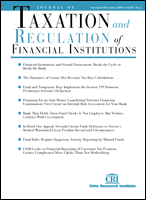Complete Issue
Author: Houman B. Shadab.
Source: Volume 24, Number 04, March/April 2011 , pp.1-60(60)

< previous article |return to table of contents
Abstract:
Spring portends change, and when it comes to even long-standing traditions in the world of financial institutions, change is certainly in the air. U.S. persons have long taken it for granted that certain non-U.S. jurisdictions afforded them tax secrecy, that they would not have to disclose their holdings to U.S. tax authorities. However, passage of the Foreign Account Tax Compliance Act (FATCA) on March 18, 2010, is likely to substantially curtail—if not eliminate entirely—the achievement of tax secrecy by placing funds in non-U.S. institutions. In the first article in this issue, Marnin Michaels, Tom O’Donnell, and Rodney Read discuss the primary means through which FATCA seeks to ensure disclosure of more information to U.S. tax authorities, namely, through the imposition of a 30 percent withholding tax on payments made to foreign financial institutions and nonfinancial entities that fail to disclose their U.S. account holders to the U.S. government. The authors provide substantial detail and practical guidance on this aspect of FATCA, focusing on the Internal Revenue Service’s first applicable guidance (i.e., Notice 2010-60). Another long-standing tradition now being upended is the nature and role of credit ratings agencies in the U.S. financial system. Many of the structured debt products underlying the recent financial crisis were created because for decades the credit ratings agencies operated under a regime of self-regulation and, in addition, were legally granted a central role in the debt markets without being subject to the same type of liability as other market participants. In the second article in this issue, James Farrell and Marcy Priedman discuss how the Dodd-Frank Act of 2010 brings a sea change in the regulation, oversight, and liability regime applicable to ratings agencies. Importantly, Mr. Farrell and Ms. Priedman discuss potential legal defenses available to the agencies, given their new status as gatekeepers in offerings made pursuant to the Securities Act of 1933. While financial markets have long operated across national boundaries, financial regulation has never had the same transnational character. This divide is likely to substantially close now, as the Dodd-Frank Act expressly calls for U.S. regulatory bodies to make their rulemaking consistent with the regulatory structures and rules of non-U.S. regimes. Indeed, several U.S. regulators have already begun the process of establishing closer ties with their counterparts in foreign jurisdictions and made explicit the goal of circumventing the ability of firms to arbitrage around national regulation. Accordingly, to appreciate the direction of U.S. financial regulation, Joanne Hindle, in our third article, reviews several of the latest financial regulatory changes emerging from the U.K., E.U., and through global bodies such as the Basel Committee on Banking Supervision. This issue concludes with Jim Goeller’s community bank column. Mr. Goeller discusses certain tax implications with respect to an S corporation bank’s disregarded entities, in particular disregarded entities in the form of Qualified Subchapter S Subsidiaries and single-member limited liability companies.Keywords:
Affiliations:
1: Journal Editor, New York Law School.